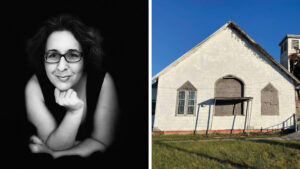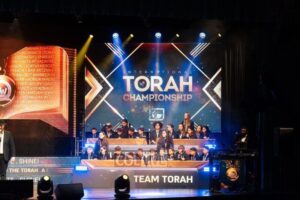‘What Took So Long!’
The following is an introduction to Dr. Eric L. Goldstein and Dr. Deborah R. Weiner’s “On Middle Ground: A History of Jews in Baltimore,” delivered by local author and Jewish historian Gilbert Sandler at the book’s launch party April 10 at the Jewish Museum of Maryland.
On a Sunday morning about 18 years ago, I stood in this room at this very podium. The occasion was the launching of a book, presented — with considerable inaccuracy as we will see —as a new and updated history of Baltimore’s Jewish community.
It was called, “Jewish Baltimore: A Family Album,” and published by Johns Hopkins University Press. Understandably, the book was seen by some as a follow-up to Isaac M. Fein’s history, “The Making of An American Jewish Community.”
But here’s where the inaccuracy comes in: the book was not, and was never meant to be, a history — the classic, well-documented and interpretive narrative of what happened. It was and is a collection of stories — rightly referred to on the cover as “A Family Album.” And I have been waiting 18 long years to make this point and see the record set straight.
One question: Dr. Eric, Deb — what took you so long?
In the introduction to the book, I wrote that “Jewish Baltimore” is only part history. It is more journalism and nostalgia and memory and folklore, laced and bound together by anecdotes and a whole lot of mamaloshen. My late wife referred to it as history by chicken soup. Spoonful by spoonful. The book grew out of a collection of articles I had written for The Sun, the Jewish Times, Generations and National Public Radio. I saw these articles as stories that defined, in warm prose, a certain place and time and world. Bob Brugger, an editor of Hopkins Press, read these same stories, and saw a book.
The critical difference between “Jewish Baltimore” and “Middle Ground” is that the former is a conversation about the times, and the latter is a true and thoroughly documented history of them. In this history, the authors are quick and wise to discern trends — movements that began small and then were writ large, and that in earlier histories were insufficiently treated — if they were treated at all.
Let me give you a few examples.
First, the authors of “On Middle Ground” introduce and then follow the trend of the historical phenomenon that saw a growing presence of Jews in the forefront of Baltimore life, taking their places in leadership ranks — in politics, the bench, industry, academia, medicine and business. They name names and go into detail of how and why the Jews in Baltimore were uniquely positioned to play such a prominent role — giving shape and tone and mood to the history of Baltimore itself. To mention some but certainly not all Jews who can be said to have changed the history of Baltimore: Jacob Epstein, Jacob Edelman, Walter Sondheim, Willard Hackerman, Zanvyl Krieger, Joseph Meyerhoff and Jeff Miller. They detail carefully how and why Baltimore’s demographics changed and how its racial and ethnic relations and economic factors contributed to the this phenomenon.
Another trend Goldstein and Weiner are the first to chronicle in a formal history is the life-altering change effected by the Jewish flight to the suburbs. The book shows how local and national trends worked together to create this flight in the decades after World War II, taking in factors such as incentives created by the G.I. Bill, race and the role of local Jewish real estate developers. Whole neighborhoods seemed to appear at once as if dropped whole from the skies. Synagogues and schools and institutions followed, and a new Jewish Baltimore was formed — suddenly in place
A third trend identified and explained is the first serious study of the growth of the Haredim (Ultra-Orthodox) community in Baltimore. In the book, the phenomenon and its consequences in Jewish Baltimore are detailed in a way that it has never been before. The authors compare the growth of Baltimore’s Orthodox Jewish community with other American Jewish communities and make clear why Baltimore’s experience was unique.
There is one story in the history of Jewish Baltimore that Goldstein and Weiner and I share in the telling that highlights the difference between their way and mine. I talk here about the coming into Baltimore Jewish life of the “Y” — the Young Men’s and Young Women’s Hebrew Association. We both present the facts, but in my accounting I add a personal memory of the place.
I was there.
Go back with me. At noon of an August day in 1933, my 14-year-old brother Irving and I, then 10, were waiting at Park Heights and Ulman avenues, bathing suits and towels in hand, for the no. 5 or 33 streetcar to take us to our summer camp at the “Y,” at 305 West Monument Street — maybe a 15-minute ride. From several sections of the city, but in particular from Lower Park Heights, there were hundreds of us young Jewish boys and girls making the same trip, The ranks of us were swelled by the largess of the Associated Jewish Charities, which in those hard-scrabble days paid the tuition — summer camp at Y for many of was free,
The Y summer camp was a three-story brick building squeezed in and among the ancient buildings and incessant traffic that made up the neighborhood of Howard and Monument streets. Hardly Maine.
Inside, activities included ping pong, basketball, dramatics and something called arts and crafts. I built model airplanes and got my picture in the paper showcasing the charitable doings of the Associated. At noon, we adjourned, from every nook throughout the building and drifted down into the basement cafeteria — time for lunch: 15 cents brought you a coke and coddie. Afterwards, the highlight of the day — a swim in the pool, which by the way was on the second floor. And after an hour or so of pool activity, we took our showers and dressed and prepared to take the streetcar home. One more day at the Y summer camp happily behind us.
I tell this story 87 years afterwards. But who knew?
By about 4:30 in the afternoon on that August day in 1933, my brother Irving and I, refreshed by a day of indoor camp activities under the Y roof, called it a day. Wet bathing suits wrapped and in our still-moist towels, we walked west to Druid Hill Avenue and caught the no. 5 streetcar –homeward bound. Another great day at the Y summer camp!
And Zionism. Eric and Deb have the facts — more than 30 citations. I have not a word about Zionism in my book. If I had included coverage, it would sound like this: “In 1934, I am 11 years old and I am standing in front of the Hippodrome Theatre. I am holding in my hand a small blue box with a white Magan David on it, and I am approaching theater-goers: ‘Money for Palestine? Money for Palestine?’”
There, right there, we separate the historian from the memoirist.
If you want to know the hard facts, complete with supporting citations, of how the Y came into being, read Goldstein and Weiner. But if you want to know how it felt to enjoy the old Y—understanding the mood, the Jewish tradition that calls for the rich to serve the poor — tzedakah – read, too, Sandler!
“On Middle Ground” is first-class scholarship, a full and authentic, the latest and best history of who we were and how we got there, documented generously and convincingly. And I go so far as to say, supported by a wealth of data in amount and thoroughness never before equaled in the several other studies that share the mission, I join you in welcoming “On Middle Ground” into the highest place in the body of our literature, and into our conversation.
One last question: Dr. Eric, Deb — what took you so long?





